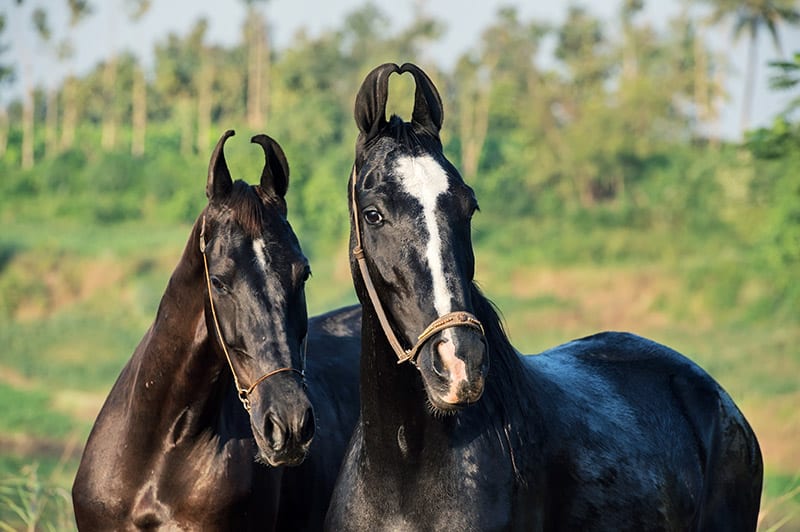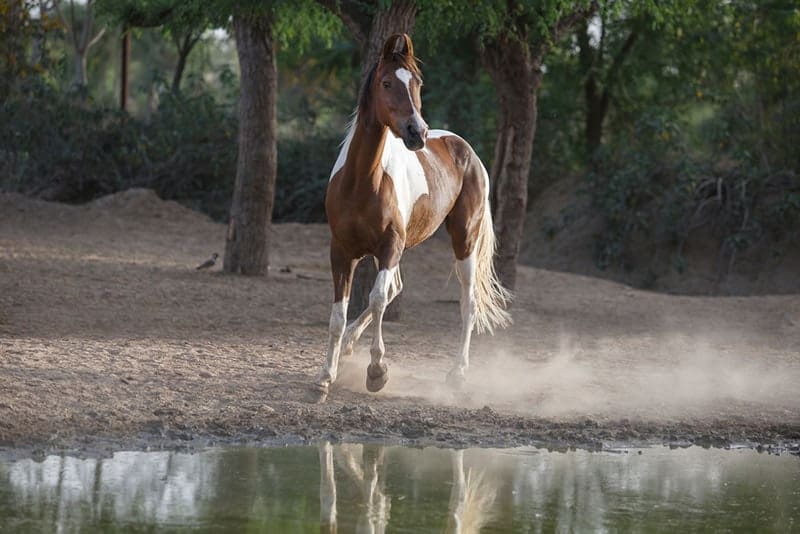The color of the Marwari is as important in this breed as is its forthright presence and arrogant bearing!
Originated in Northwest India, the Marwari ia a proud and aristocratic breed. It was the war horse of India’s elite Rathore warriors. They used this horse to help defend the area near the Khyber Pass in Pakistan, a gateway between the two countries. It survived centuries of political turmoil and the deeds of this loyal, bold warhorse are recorded in prose, poetry and song.
The Marwari horse is also famed as a bejeweled dancing horse of formal ceremony and celebration. A strain of the breed, the Natchni, is reputed to be “born to dance”. Their grace and beauty are in high demand at ceremonial events in India.
The Marwari horse is easily recognized by its distinctive ears. They are lyre shaped and often meet at the top to form an arch. Its ears often touch together when pricked.
Though a small horse, standing only 14.3 to 15 hands high, it is extraordinarily hardy. Bred to thrive in a sparse, hot environment it is naturally tough and competitive. The Marwari is an ideal breed for endurance riding. Today it is a highly valued indigenous horse of India. It has a specific standard dedicated to maintaining the vigorous and aesthetic qualities of the breed.
The stepdaughter of the Ambassador to Cairo, Francis Kelly. became enthralled with the Marwari and in 1995 began the task of exporting a few of them to the United States. Ms. Kelly describes riding a Marwari as “to view the path ahead through a pair of perfectly curved ears, a gateway to the heart of India’s spiritual and ceremonial heritage.” In 1995 the Marwari Bloodlines was founded by Francesca Kelly and Raghuvendra Singh. Their goals are to “preserve, promulgate and promote the Marwari horse in India and abroad”. There are currently only a few Marwari in the U.S. According to Ms. Kelly, in 2005 there were 9 in the U.S. One can be seen at the prestigious Kentucky Horse Park in their Parade of Breeds. Recently British Industrialist Anthony Bradford purchased two mares and a filly, which were sent to England.
The scope of Ms. Kelly’s experience however, doesn’t account for all other breeders of this magnificent horse. For example, Gaurav Joshi says they have “known this breed from 1973 and we are keeping them like Marwari.” So the number of these horses in the U.S. is not fully known.
Scientific Classification
| Kingdom: | Animalia |
| Phylum: | Chordata |
| Class: | Mammalia |
| Order: | Perissodactyla |
| Family: | Equidae |
| Genus: | Equus |
| Species: | caballus |

Horse Breeds
The are a light horse breed. Light horse breeds generally weigh under 1,500 pounds. They are typically used as riding horses for leisure and trail riding. Being agile and swift, many are also used on the racetrack, in the show ring, and for work on the ranch.
Light horses are grouped in a couple of different ways, one being the continent or country where they originated from. They are also grouped according to training, classified as either a stock type, hunter type, saddle type, or ‘other’. A body type is generally attributed to each class, with the ‘other’ classification being a bit of an odd ball. It includes those that are color breeds or those that may fit a body type of one of the training classes, but not be used for that type of training. In some cases the ‘other’ types can also include those that may fit into more than one of the type groups.
The horse class the Marwari Horse primarily fits into is the hunter type class as it is well adapted to the rigors of dressage. It is also is ideal for endurance riding.
Horse Backgrounds
The Marwari breed originated in Northwest India. The nearby Khyber Pass in Pakistan served for centuries as the gateway for invasion into southern Asia. The local inhabitants, the Rajputs, were a warrior tribe dedicated to their horses and skilled at cavalry warfare. For centuries, they defended this area with the help of their loyal and bold warhorses, the deeds of which are recorded in prose, poetry and song.
The Marwari thrived through centuries of political turmoil, until the arrival of the British decimated the breed in the first half of the 20th century. Preferring the horses they were used to, the British imported their own horses. Further, they enacted laws preventing Indian Noblemen land owning rights. Consequently, thousands of Marwari were shot, sold off for cheap labor, castrated or indiscriminately cross bred. A few held out on small remote farms, and when researchers were encouraged to take an interest in promoting the indigenous breeds, they began to make a comeback.
Tourism and riding safaris became popular in the later half of the century and the breed began to recover. In 1995, Francis Kelly, the stepdaughter of the Ambassador to Cairo, became enthralled with the breed and undertook the enormous task of exporting a few to the U.S.
Description
The Marwari is a small horse, standing 14.3 to 15 hands high. Its ears often touch together when pricked, and Ms. Kelly describes that to ride a Marwari is “to view the path ahead through a pair of perfectly curved ears, a gateway to the heart of India’s spiritual and ceremonial heritage.”
They have many qualities adapted to desert life such as acute hearing, long eyelashes, long legs, and a forward and upright shoulder. Withers are well defined and in proportion. The chest is not too broad, with well sprung ribs, deep loins, and a long well rounded croup. The expressive head is placed on a neck that is graceful and arched. The profile is straight or slightly roman nosed, and the jaw well rounded with a deep throatlatch to encourage flexion.
The original breed characteristics are concerned as much with personality and color patterns as confirmation. There should be a handsome, forthright presence and arrogant bearing in the stallion and doe eyed beauty in the mare. Grey is the most coveted color and demands the highest price, and bright bay is also very desirable. Albinos are only allowed for religious ceremonies and chestnuts are a sign of outbreeding and not accepted. Black is undesirable and considered ominous. Piebald and skewbald are allowed, and a white blaze and lower legs is common. Whorls below the eyes are unfavorable, but whorls on the neck and fetlocks are considered good luck.

Horse Care and Feeding
These horses have an efficient digestive system, and do not need as much fat and carbohydrates as most other horses. They are used to having free range and if confined to a stall, they must be given exercise regularly. They are social and aristocratic, and will not tolerate inattentiveness.
Horse Training and Activities
This breed is well adapted to the rigors of dressage. They are naturally competitive, and their hardy nature is ideal for endurance riding. Some Marwari are gaited and perform a gait known as the aphcal or revaal, which is a straight tracking amble.
According to Horsemarwari.com, “he is a tough, brave and undeniably beautiful horse who has proven his ability to adapt and thrive in most environmental conditions. His royal history and scarcity should guarantee him a deserved status in the international equestrian arena.”
Common Health Problems
The Marwari horses are extraordinarily hardy and thrive in a sparse, hot, environment. If they are to be kept in a cold weather climate, they must be given time to acclimate gradually. They have very few soundness problems.
Availability
There are currently only a few Marwari in the U.S. The Marwari Bloodlines Dundlod, and Marwari Bloodlines Chappaquiddick are centers for information on the purchase of the Marwari horses, breed information, bloodline registration, shows, competitions and adventure horse safaris. More information concerning purchasing one of these lovely horses can be found from the Indigenous Horse Society of India.
Featured Image Credit: Daria Koskova, Shutterstock
